| Medium Tanks of the T-34 Series |
|---|
|
|
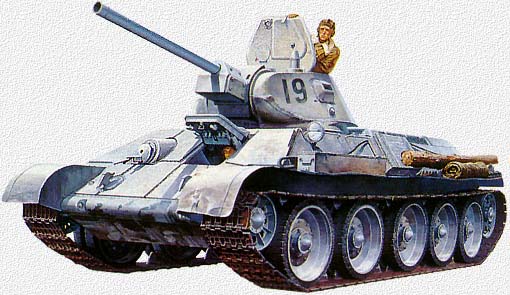
On June 5, 1940, the SNK USSR and Central Committee of the Communist Party signed a resolution "About manufacturing T-34 tanks in 1940", which says:
"Attaching importance to equipping the Red Army with T-34 tanks, Council of the Peoples Commissars of the Soviet Union and Central Committee enacts:
1. Require People's Commissar of the Machine-Building Comrade A.I.Likhachev:
a. to produce 600 T-34 tanks in 1940:
- by factory #183 - 500 tanks;
- by Stalingradsky Tractor Factory - 100 tanks; and
- by the following plan:
Month VI VII VIII IX X XI XII Factory #183 10 20 30 80 115 120 125 STZ - - - - 20 30 50
b. to supply the whole program 1940 with diesel engines, for that purpose need to increase the V-2 production by factory #75 and manufacture 2,000 engines until the end of year..."
Nevertheless this plan failed. Moreover, in summer 1940 the clouds were gathering over the T-34. The point is that two Pz-IIIs were bought in Germany and delivered to Kubinka for comparative tests. Soviet documentation does not clarify the exact modification of the Pz-III, in all cases it was named as "German T-III". The results were unfavourable for the Soviet T-34. The T-34 was superior in terms of protection and firepower, but that's all. The Pz-III had a cosy three-man turret with a commander's cupola. Each crewman had an internal communication device at his service. In contrast, the T-34 had a very cramped two-man turret without a commander's cupola. Only the tank commander and the driver had internal communication. The German tank had a very smooth motion and wasn't as noisy as the T-34: moving with maximum speed the Pz-III could be heard from 150-200 metres while the T-34 could be heard from 450-500 metres. |
Soviet engineers were surprised by Pz-III's maximum speed. It was far superior and could run up to 69.7 km/h whereas the T-34's best result was 48.2 km/h. The BT-7, which was used as a standard model, could run on wheels at only 68.1 km/h. The report of those tests indicates that the Pz-III had better suspension, a high quality of German optics, a handy layout of ammunition and radio, and a reliable engine and transmission. By those results the GABTU issued a summary document for Marshal G.I.Kulik, who affirmed it and ordered production of the T-34 to cease until improvements were made in all revealed defects and drawbacks. Large wrangles occurred. They've were cancelled by the personal meddling of Marshal K.E.Voroshilov: "Tank production must be continued with guaranty race of 1,000 km. Factory must develop a new tank - T-34M with improvements not only in its protection but also in running capabilities, so the new five-speed gearbox should be used." |

At that time, M.I.Koshkin's health became worse as he was taken ill with single pneumonia in March 1940. On September 26, 1940, he died. A.A.Morozov became the Chief-engineer of the T-34 project. Under his guidance the design bureau developed two variants of the T-34's modernisation. The first variant, named the A-41, was an attempt to improve most of defects without developing a new hull and drive train. It had a new three-man turret with a ring diameter of 1,700 mm (standard T-34 has a diameter of 1,420 mm). It was intended to rearm with the newest 76.2 mm F-34 gun, but due to unclear reasons that project was left on paper. The second variant, named the A-43 and also known as the T-34M, was narrower, higher and longer than the production T-34. |

Simultaneously with the A-43 development, the Factory #183 continued mass production of the T-34. The first three tanks left the factory's gates by September 15, 1940. Until the end of year a total of 115 tanks were produced or 19% of the initially planned output. STZ didn't produce anything at all. All it could make were 23 half-assembled tanks. Such a dramatic situation is quite understandable. The T-34 was a completely new tank, it required new technologies to be introduced successfully. Suppliers and manufacturers of various elements of the T-34 also needed time to adjust their technology bases. For example, Mariupol's turrets needed to be improved due to their inaccurate geometry and dimensions. In spite of simplified assembling techniques (for instance the frontal glacis was now welded from two armour plates), the T-34's production was still very difficult and as a result very expensive. With enormous effort factory #75 could produce a V-2 engine that worked 150 hours without a failure! Such huge problems! A special test bench was built for verifying the correct and accurate dispersion of fuel and it's even feeding. All 12 atomisers of the V-2 were tested here. All atomisers, valves and needles were manually ground in. T-34s of the first series were armed with the 76.2 mm L-11 gun. Mass production of L-11 guns was cancelled in 1939 in favour of the F-34 gun, so only about 400 T-34s were armed with the L-11. Tanks of all other modifications were armed with either the F-34 or its modernised variant the F-34M. Being more powerful than the L-11 or F-32, that gun was developed in 1939 by Grabin's design bureau. Initially it was supposed to be used for T-35 and T-28 tanks. On October 19, 1939, mounted on a T-28, the F-34 was tested on the Gorokhovetsky proving ground. From 20 to 23 November 1940 the F-34 was tested in a T-34 tank (the tests consisting of 1,000 shots). As a result of those tests the F-34 was recommended to be accepted for service. Please remember! Despite being a commonly held view, not one T-34 was armed with the F-32 tank gun! |
At the same time, according to order #76791 of the Minister of Defence (October 25, 1940), the first three T-34s were tested intensively on the Kubinka proving ground. A special commission revealed so many defects and drawbacks that it doubted the T-34's combat capabilities. Questions about cancellation of production and even abandonment of the whole project (!!!) were raised again. Furthermore, some of the leaders of GABTU and Ministry of Defence maintained the idea that the T-50 should be the most mass produced tank, not the T-34. |

Such a position wasn't accidental. As is known, on July 9, 1940 the Soviet High Command decided to form nine mechanised corps. By its organisation, each mechanised corps consisted of two tanks and one motorised division. Each tank division had 63 KV heavy tanks, 210 T-34 medium tanks and 102 light tanks (either BT or T-26 or both). Each motorised division had 275 light tanks (usually T-26). So the T-50 was intended to replace that large park of "outdated" vehicles. In February-March 1940, another 20 mechanised corps were formed using the same TO&E. Also many light tanks were needed to complete the tremendous number of Soviet rifle divisions (each rifle division had 16 tanks). So it is not too hard to calculate the entire number of medium tanks which should be produced to form all these corps: at least 4,620 medium tanks. At that time Soviet industry could produce only three T-34s.
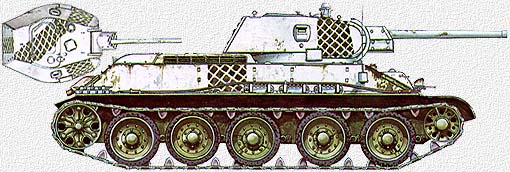
Chief of the GABTU Y.N.Fedorenko and Chief of the GAU G.I.Kulik supported by the Commander of the Western Military District D.G.Pavlov, proposed to cease the T-34's production until the works on the T-34M were finished. The BT-7M's mass production should be resumed instead of the T-34's. For reasons which are unclear that proposal was rejected.

On June 25, 1941, the SNK USSR and the Central Committee of the Communist Party issued a decree "About increasing the manufacturing of KV, T-34 and T-50 tanks, artillery tractors and tank diesel engines in the III and IV quarters of 1941" in which the task to form a complex Tank Industry was given. On July 1, 1941, GKO issued another decree #GKO-1ss which required the "Krasnoye Sormovo" factory #112 to join the production of T-34s. The factory was required to mount an M-17T petrol engine. Mass production of that engine must have been set up in one of the GAZ's workshops, before that it had produced aircraft engines. A decision to mount a petrol engine instead of diesel was temporary and was connected to shortage of V-2 engines: by that time the only factory #75 produced them, all other suppliers were evacuated so they were simply unable to produce anything. By November 1941 mass production of the V-2 was set up in the STZ factory, but by then factory #75 was "on wheels" being evacuated to the East, so the total output of diesel engines wasn't increased.

The production plan of the "Krasnoye Sormovo" supposed 750 "petrol" tanks to be produced until the end of the year. Unfortunately, it had completed only 173 tanks.
At the same time, the Factory #183 increased its output. Employees worked in two shifts (12 hours each). Production didn't cease even when the Germans bombed the factory.
| Month | VII | VIII | IX | X |
|---|---|---|---|---|
| Production | 250 | 250 | 250 | 30 |
As shown in the table above, the very last tanks were assembled when the factory was partially destroyed or evacuated. Ordered by decree #667/SGKO which was dated September 12,1941, director of factory U.E.Maksarev started the evacuation process. On September 19, 1941, the first rail echelon had left Kharkov and set out for the Ural Mountains. Once in the new location, Nizhnij Tagil, a new factory was built in a very short time. It got its old number - #183. By December 1941, the new factory could produce 25 tanks using elements which were evacuated from Kharkov.
Looking back on autumn 1941, I can confirm that the Stalingradsky Tractor Factory (STZ) was, in essence, the single serious T-34 manufacturer. Now it is understandable why most of STZ's suppliers were set up in Stalingrad as well: mainly to reduce the T-34's cost price and to increase the output of the STZ as much as possible. Armour plates were manufactured by the "Krasniy Oktyabr" factory ("Red October"). Hulls were manufactured by the Stalingradsky Dockyard (factory #264). In short, a full manufacturing industry was organised in one place, which is quite unusual for any complex industry. In the first half of 1942, the T-34 was manufactured by three factories: Tanks of these factories have similar technical characteristics but their details differed significantly. |
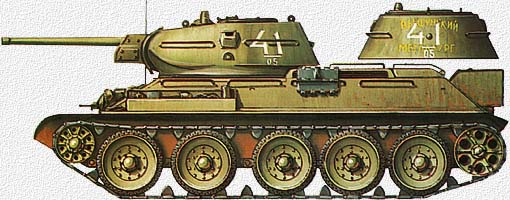
Since most suppliers were lost to the Germans, Soviet tank producers showed wonders of resourcefulness. For example, due to the loss of Dnepropetrovsk, the supply of gas-cylinders for engine emergency starting ceased. So the "Krasnoye Sormovo" used rejected cartridges from artillery shells. In the STZ most of the welded details were replaced with cast because STZ had one of the best foundries in USSR. As the Germans advanced on Stalingrad, most of STZ's external supply lines had been cut off, rubber for instance. So the T-34s from the STZ had one specific feature: their road wheels didn't have a rubber tyre. Actually, by the end 1942, all other T-34 producers manufactured tanks with the same type of road wheels. The factory in Stalingrad produced tanks until the Germans approached the factory's walls. Today we have an opportunity to imagine the conditions it worked in: "From the beginning of artillery bombardment and air strikes on the factory's territory, the Workshop #5 had done the following: |
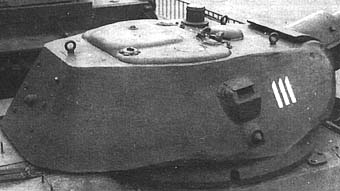 The cast turret of the T-34-76 of the Factory #183 (M.Baryatinsky) |
From October 5, 1942, according to an NKTP order, all works in the STZ were cancelled and employees evacuated. The rest of factory walls were wiped out during hot battles in Stalingrad. Striving to compensate for the evident loss of the STZ, in June 1942, GOKO ordered Kirovsky factory in Chelyabinsk (ChKZ) to begin mass production of the T-34. The first tanks were ready by August 22. In March 1944, production of the T-34 by the ChKZ factory was cancelled. |
Uralmash started mass production of hulls and turrets from April 1942 and supplied them to factory #183. In July 28, 1942, being ordered by GOKO's decree #2120, Uralmash then began mass production (assembling) of a whole T-34. The first tank was manufactured in September 1942. Constructors I.F.Varhushev and V.S.Arseniev developed a new pressed turret (see photo). From October 1942 to March 1944 Uralmash manufactured 2,050 of these turrets, and sent a significant number of those turrets to ChKZ. Uralmash did not manufacture the T-34 for very long. From August 1943, it switched to various SP guns which were based on the T-34's chassis. In 1942, the Factory #174 was evacuated to Omsk, and launched T-34 mass production. In August 1942, a new turret was developed. It had a hexagonal form, and all documents of that time named it "a turret of improved form". It was better then all previous turrets but still was very cramped. It had two rounded hatches instead of the previous "united" hatch. The turret also received an air ventilator that was mounted on the roof under the armoured cupola. Furthermore, the tank received an improved air filter "Cyclone", a 5-speed gearbox, and cylindrical external fuel tanks (up to four tanks, one of them always filled with oil, the rest were filled with fuel). In summer 1943, the "Krasnoye Sormovo" had developed the new cast commander's cupola and began to mount it. Uralmash had proposed its own variant of a pressed commander's cupola, but it was rejected. |
T-34-76 was produced until mid-1944. Then it was replaced with its upgunned variant - the T-34-85. The "Krasnoye Sormovo" also developed and produced 68 T-34-76 protected with anti-HEAT shields (skirts) like those on most of the German tanks. It supposed these skirts would protect them from German HEAT ammunition, but it wasn't checked. In the very first battle common 75 mm AP rounds destroyed most of those tanks. The idea was considered as hopeless and was abandoned. |
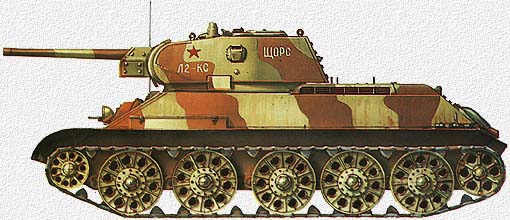
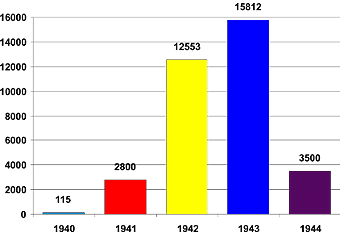
| Designation | Russian name | English transcription | City | Notes |
|---|---|---|---|---|
| #183 KhPZ | Kharkovsky Parovozostroitelny Zavod | Kharkov Steam-Engine Plant | Kharkov | Before autumn 1941 |
| #183 UVZ | Uralsky Vagonostroitelny Zavod | Ural Rail-Car Plant | Nizhnij Tagil | There is KhPZ after evacuation in October 1941. |
| STZ | Stalingradsky Tractorny Zavod | Stalingrad Tractor Plant | Stalingrad | - |
| #112 | "Krasnoye Sormovo" | "Red Sormovo" | Gorkij (today - Nizhnij Nivgorod) | - |
| UTZM | Uralsky Zavod Tyazhelogo Machinostroyeniya | Ural Plant of Heavy Machine-Building | Sverdlovsk | - |
| ChKZ | Chelyabinsky Kirovsky Zavod | Kirov's Plant in Chelyabinsk | Chelyabinsk | There is Kirov's Plant after evacuation from Leningrad |
| #174 | - | - | Omsk | - |
| Years | Output per quarter | Yearly output |
%% from planned output | |||
|---|---|---|---|---|---|---|
| I | II | III | IV | |||
| 1941 | 385 | 450 | 695 | 55 | 1 585 | 88.9 |
| 1942 | 440 | 1 380 | 1 774 | 2 090 | 5 684 | 119.7 |
| 1943 | 1 600 | 2 835 | 2 009 | 2 022 | 7 466 | 100.1 |
| 1944 | 1 991 | 2 107 | 2 149 | 2 182 | 3 429 | 100.6 |
| 1945 | 2 157 | 2 153 | 1 858 | 1 190 | 7 358 | 100.8 |
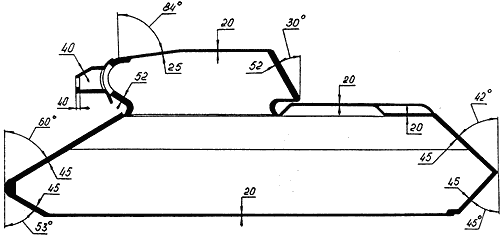

Sources:
"The T-34 tank. Operational manual", Voenizdat, 1941; "The T-34 tank. Handbook", Voenizdat, 1944; "About manufacturing T-34 tanks in 1940" AP RF. F.93. Document collection; Bronekollektsiya #3, 1999; I.Shmelev "The T-34", Technics and Armament #11-12, 1998; J.Magnuski "Wozy bojowe", LWP, Warsawa, 1985; "Soviet tanks in combat 1941-1945. The T-28, T-34, T-34-85 and T-44", Concord publ. company; S.Zaloga, J.Grandsen "T-34 in action"; Cover picture - A.Aksenov |